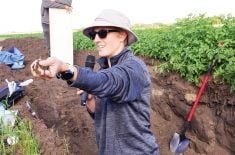Healthy soil is a living ecosystem, vibrant with the activity of vast numbers and staggering diversity of organisms.
According to soil scientist Elaine Ingham, a single teaspoon of productive soil contains 100 million to one billion bacteria, not to mention fungi, protozoa and nematodes.
Every farm depends on the health of the soil, but soil stewardship is especially important to organic farmers.
The first two principles of organic management listed in the Canadian Organic Standard are:
• protect the environment and minimize soil degradation and erosion;
Read Also

Soybean market still figuring out implications of China-U.S. pact
Soybean futures had a muted reaction to the U.S. trade deal with China as the market tries to figure out the nuances of the deal.
• maintain long-term soil fertility by optimizing conditions for biological activity within the soil.
Are organic farms meeting these goals?
The answer from Europe and the United States, where organic research has a longer history, seems to be yes, at least in terms of encouraging biological activity and decreasing erosion.
Two classic studies in the journals Science and Nature compare soils after long-term organic or conventional management.
One study, led by Paul Mader, was from research plots in Switzerland, while the other, led by John Reganold, was from farms in the Palouse region of Washington state.
Both found abundant evidence of greater microbial activity in organically managed soils.
The biomass of microbes was higher, as was their activity, which was measured by looking at the amount of enzymes and polysaccharides they produced.
Polysaccharides are sticky and hold soil particles together, giving soil a higher aggregate stability and resulting in less erosion.
Reganold’s group also found that topsoil was deeper on the organic farm, which they attributed to greater erosion on the conventional farm.
Mader’s group measured the level of mycorrhizal association and found it to be 40 percent higher in organic systems than conventional systems.
Mycorrhizal associations between fungi and plants allow plants to access nutrients and water more effectively in times when these are limiting. Associations with mycorrhizal fungi can also reduce infection by pathogenic fungi.
Mder’s group also looked at small above ground predators that are sensitive indicators of soil activity.
The average activity and number of carabid and staphylinid beetles and spiders in organic plots was almost twice that in conventional plots. Some specialized and endangered beetle species were found only in the organic systems.
The presence of top predators in an ecosystem is considered important o maintaining balance. Without predators, bacteria and fungi that cause plant disease and parasitic nematodes can become problems.
Reganold’s team found that the organic farm had higher organic matter content than the conventional farm. Greater soil organic carbon is an environmental benefit because it is one way to reduce greenhouse gases.
Higher levels of soil organic carbon was associated with increased water storage and improved granulation, which means it crumbles rather than forms hard lumps after repeated wetting and drying.
Reganold’s group also found that the soil was easier for emerging seedlings to break through.
Prairie research is beginning to confirm many of the international trends.
Organic versus conventional
Alison Nelson, a graduate student at the University of Alberta, found higher levels of bacteria and fungi in organically managed soil than in conventionally managed soil near Edmonton.
Cathy Welsh, a graduate student at the University of Manitoba, found that mycorrhizal populations were greater in organically managed soils than conventionally managed soil near Winnipeg.
Nelson also found that aggregate stability was higher in organically managed soil sampled across the Prairies.
Increases in soil organic carbon on the Prairies have traditionally been attributed to reduced tillage and a declining use of summerfallow.
Organic farmers are often criticized for relying on tillage rather than chemistry for weed management, and for the use of a green manure fallow rather than chemical sources of nitrogen.
Nelson’s studies suggest that although there are greater levels of tillage on organic farms, aggregate stability is still higher on organic farms, and thus erosion potential is reduced.
Studies led by Bix Biederbeck at Agriculture Canada’s research centre in Swift Current, Sask., found that green manures can increase soil organic carbon and the abundance of soil microbes.
Nevertheless, tillage associated with green manure is a concern for researchers and organic producers.
Martin Entz at the U of M and Steve Shirtliffe at the University of Saskatchewan are looking at the potential of mowing and using a crimper roller to terminate green manures without tillage.
Entz is also looking at grazing green manures rather than tilling them.
The study of these reduced tillage options may help reduce the trade-off between the benefits of green manure and the risks of tillage.
What about soil fertility?
A number of studies on organic farms show varying levels of available nitrogen. Differences probably reflect different levels of animal manures and green manure crops in organic systems.
Diane Knight at the U of S took soil samples from organic farms in Saskatchewan and found that organic producers do have the tools needed to effectively manage nitrogen.
She found that levels of soluble phosphorus were consistently low in organic fields in Saskatchewan. Levels were also low in Mder’s study.
Mder’s group found more of the phosphorus was bound in the microbial biomass, which meant plants were receiving phosphorus from the activity of the microbes.
Knight is continuing her research on phosphorus sources on organic farms.
Other soil nutrients have received less attention.
Mder’s group found potassium levels to be lower but calcium and magnesium levels to be higher on organic farms.
Knight found that potassium and sulfur levels were generally good on organic farms in Saskatchewan, where soil is naturally blessed with potassium and calcium as part of their legacy as a prehistoric sea.
Crop yields are a good measure of soil fertility. Most studies that compare yields of organic and conventionally managed grain in extensive systems find that organic yields are lower than conventional yields.
However, some argue that the measures tend to be biased by the inclusion of research plots with rigid or unrealistic protocols and newly organic fields where biological systems are not yet fully developed.
The goal in organic agriculture is optimizing biological systems rather than maximizing them.
Derek Lynch, who reviewed studies reporting environmental benefits of organic farming, found there may be trade-offs between today’s yield and long-term environmental or ecological benefits.
Perhaps an analogy might be between chemical fertilizers and steroid use: steroids may improve short-term muscle bulk but may not be in the best interests of the overall health of the user.
Studies into the biological function of soil are only beginning. We know little about the billions of organisms there and even less about the relationships among them.
Perhaps in this way the soil is a new frontier, difficult in many ways to observe but of vital importance.
Organic farming is striving to protect and enhance the soil ecosystem. In many ways it is succeeding.
Brenda Frick, Ph. D., P. Ag. is an extension agrologist and researcher in organic agriculture. She welcomes your comments at 306-260-0663 or e-mail organic@usask.ca .















